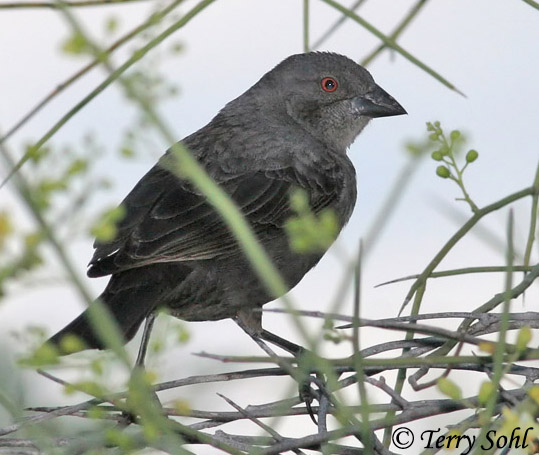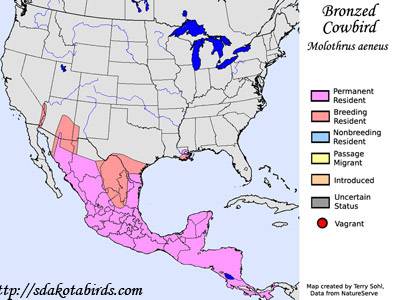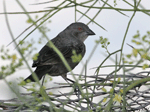| Length: 8.75 inches | Wingspan: 14 inches | Seasonality: Non-resident in South Dakota |
| ID Keys: Males dark with glossy blue wings. Females grayish overall with red eye. | ||
 The
Bronzed Cowbird is a cowbird species of Central America and Mexico with a
range that crosses into the southwestern United States. Like the more
common and widespread Brown-headed
Cowbird of the U.S., Bronzed Cowbirds are brood parasites, laying their
eggs in the nests of other species. Female Bronzed Cowbirds will lay a
single egg in the nest of another species about once a week, a behavior that
may last for several weeks. She will also often destroy existing eggs
in the nest, leaving the parent to raise her young. As with the
Brown-headed Cowbird, they appear to have adapted well to a human presence,
and have significantly expanded their geographic range over the last 100
years. They used to be absent from Arizona, but are now commonly found
there, and are also much more common in Texas than they were historically.
The
Bronzed Cowbird is a cowbird species of Central America and Mexico with a
range that crosses into the southwestern United States. Like the more
common and widespread Brown-headed
Cowbird of the U.S., Bronzed Cowbirds are brood parasites, laying their
eggs in the nests of other species. Female Bronzed Cowbirds will lay a
single egg in the nest of another species about once a week, a behavior that
may last for several weeks. She will also often destroy existing eggs
in the nest, leaving the parent to raise her young. As with the
Brown-headed Cowbird, they appear to have adapted well to a human presence,
and have significantly expanded their geographic range over the last 100
years. They used to be absent from Arizona, but are now commonly found
there, and are also much more common in Texas than they were historically.
Habitat: Found in a variety of semi open habitats, from the edges of woodlands to open agricultural fields and grasslands.
Diet: Feeds on seeds and insects.
Behavior: Most foraging is done by walking on the ground. Like other blackbird and cowbird species, they will sometimes associate with cattle in order to forage on insects kicked up by their grazing activity.
Nesting: The Bronzed Cowbird doesn't build its own nest, but lays its eggs in the nests of other birds. Females are often rather prolific egg layers, and may lay a single egg a week for several weeks, taking advantage of variable breeding times of multiple bird species.
Song: Song of a Bronzed Cowbird is a mellow, ascending, whistled song with a gurgling phrase at the start and finish.
Migration: Considered a permanent resident in Mexico and Central America. In the northern part of their range in the U.S., most birds move a short distance southward for the winter, although small numbers may be found locally in the desert Southwest in winter. Some also tend to move eastward in the fall, with strays sometimes reaching as far east as Florida.
Interactive eBird Map: Click to access an interactive eBird map of Bronzed Cowbird sightings
Similar Species: Most similar to Shiny Cowbird.
Feeders: Will occasionally attend feeders for various seeds.
Conservation Status: Populations are widespread and relatively common in many parts of their range. The IUCN lists the Bronzed Cowbird as a species of "Least Concern".
Further Information: 1) Audubon Guide - Bronzed Cowbird
2) Texas Breeding Bird Atlas - Bronzed Cowbird
3) WhatBird - Bronzed Cowbird
Photo Information: Photo taken by Terry Sohl - May 7th, 2008 - Near Tucson, Arizona
| Click below for a higher-resolution map |
 |
| South Dakota Status: Non-resident in South Dakota |
Additional Bronzed Cowbird Photos

